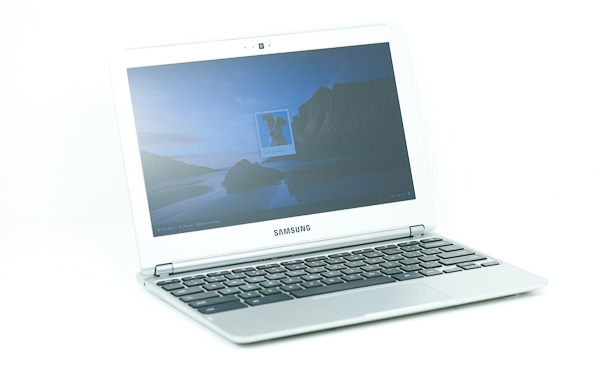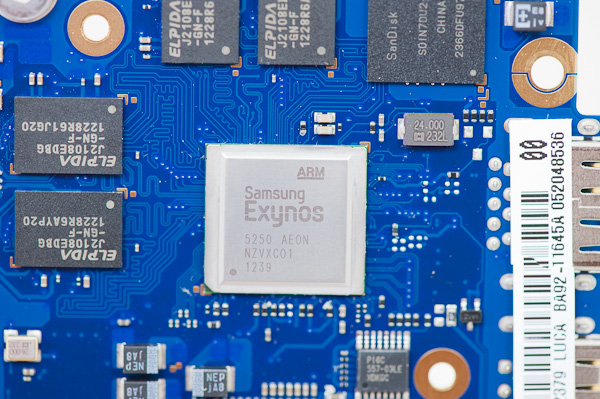Samsung Chromebook (XE303) Review: Testing ARM's Cortex A15
by Anand Lal Shimpi on October 31, 2012 9:00 AM ESTGoogle announced the Chrome OS project two years ago, and with it came the first Chromebook: the CR-48. The Chrome OS concept seemed revolutionary at the time. In 2010 we were well into the latest round of questioning whether today's PCs were fast enough. The Ultrabook revolution hadn't yet begun, and the iPad was starting to gain momentum. Capitalizing on the market being flooded with poor quality, yet affordable PC notebooks that still struggled with the same virus/malware issues they'd been facing for years, Google took the opportunity to attempt to revolutionize the PC OS.
Chrome OS was that attempt at a revolution. As an OS built around a web browser, Chrome OS offered many of the advantages that the Chrome browser itself brought to the table: sandboxing, guest mode and constant/painless updates. All user data is encrypted on the drive by default. Security was and remains a major feature of Chrome OS.
Google's revolution extended to hardware as well. The Cr-48 notebook delivered a good keyboard, trackpad and solid state storage. Future Chromebooks would do the same. While the price points of these machines (<$500) kept ultra high resolution IPS displays out of the bill of materials, Google promised good build quality and solid state storage - two things you couldn't find in cheap notebooks of the time.
Since then, some of the traditional PC makers have woken up. Although confined to the $999+ price point, we're finally seeing attention paid to build quality, display quality and storage performance. Over the next couple of years there's going to be increased focus on bringing those premium features down to sub $700 price points.
For Chrome OS and Google's Chromebooks to remain relevant, they also had to move down the pricing stack. With its most recent announcement, Google has done just that. The new Chromebook (Samsung XE303C12) is priced at $249, while maintaining much of what made its predecessors interesting.
Even more interesting than its aggressive price point is the choice of SoC inside Google's new Chromebook: Samsung's Exynos 5 Dual, featuring two ARM Cortex A15 CPU cores. This move makes the new Chromebook the very first non-x86 machine to ship with Chrome OS. Given that I also happen to have a dual-core Atom based Chromebook from 2011, the new Exynos 5 based machine gave me a unique opportunity to get a preview of how ARM's next-generation CPU core would stack up against Atom.













149 Comments
View All Comments
jeffkro - Wednesday, October 31, 2012 - link
Krait, might loose out to this A15 in all out performance but it is pretty great for battery life especially on LTE phones.Krysto - Thursday, November 1, 2012 - link
LTE has nothing to do with the chip. Those quad core S4 Pro's aren't even integrated with LTE yet. Latest LTE efficiency comes from the fact that it's made at 28nm, not at 45nm - the LTE chip itself that is.tipoo - Wednesday, October 31, 2012 - link
Impressive that the A15 beats Atom across the board, and draws significantly less power doing that. Complete leapfrog.eddman - Wednesday, October 31, 2012 - link
Not a valid comparison IMO when it comes to power consumption. That's an old 45nm Atom. Clover trail will do much better, thanks to the 32nm process and its new S0ix power states.tipoo - Wednesday, October 31, 2012 - link
Fair enough, but the performance per clock won't go up significantly until Silvermont.silverblue - Wednesday, October 31, 2012 - link
Still, the current Atom and Brazos are only mild updates (if that). The E2-1800 in HP's dm1 gets 547 in Sunspider, so clock-for-clock, Brazos 2.0 is ahead on this single test. However, the power consumption must be signicantly more. Still, slightly different markets.I would very much like to see the next Atom plus AMD's Jaguar; reduced power and better performance could make for a decent A15 competitor.
lmcd - Thursday, November 1, 2012 - link
Supposedly these were the leaky chips, so we could have a similar story in Samsung's favor.Krysto - Thursday, November 1, 2012 - link
Brazos has a much higher TDP though. Was it 10W for CPU and another 8 for the GPU? It's crazy.Krysto - Thursday, November 1, 2012 - link
Clover Trail is not a mobile chip. Only Medfield is, and they don't even have a dual core version yet. You will never see Clover Trail in smartphones (yet you will see Cortex A15), and the only reason you will see them in Windows 8 tablets is because Medfield would be too slow with Windows 8, and Clover Trail is more powerful, but also uses much more power, and they are willing to compromise on that, while lying through their teeth that it will get 8-9h of battery life. It will get nowhere close to that.wsw1982 - Thursday, November 1, 2012 - link
the clover trail is about 3.5+ w tdp according to some review. the samsung a15 is a 6+w soc. what make you think a 3.5 w soc cannot go to mobile, but a 6+w soc can?